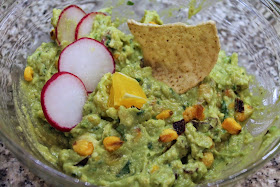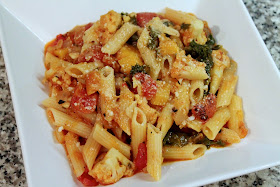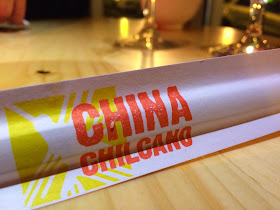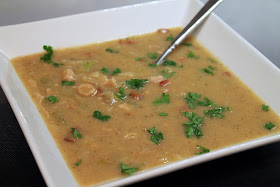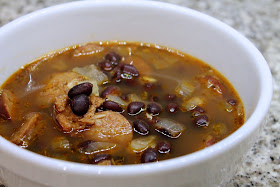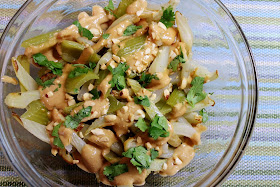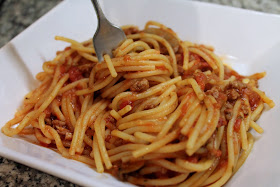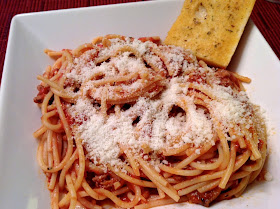[Update: White Street has closed.]
There are a lot of reasons we enjoy occasional visits to New York City, but one of the best ones is the food. We always eat well when we go there, and I put a lot of thought into where we should go, balancing the desire to try new places with the tug of old favorites.
The new places we visited included a coal-fired pizzeria, exquisitely well-prepared classics and our new favorite Mexican restaurant.
 |
| Guacamole - The Black Ant |
The Black Ant
We've sampled Mexican restaurants in New York before, but hadn't yet found a true favorite until we visited
The Black Ant. Chris found this restaurant in an article about the recent surge in great Mexican restaurants in New York. The Mexican food at this small East Village space was creative, beautifully composed and incredibly delicious.
Given it's name, expect to find black ants inside, although not in the food--they adorn the walls in various sizes. However, there are other insects on the menu: grasshoppers show up in a bisque and a hash. We stayed away from ordering invertebrates and still found plenty to love on The Black Ant's diverse menu.
 |
| Devil in Oaxaca - The Black Ant |
The drinks and guacamole quickly established that this was a place we were going to like. The avocado dip arrives is mashed as usual with tomato and cilantro, but is also artfully decked out with crunchy toasted corn, dried black chiles, radishes and an orange wedge. It comes served with the kind of thick tortilla chips we love, which really are necessary to hold up to a chunky guacamole. Cocktails showed similar inventiveness. I loved the Devil in Oaxaca, made with mezcal and carrot juice.
Our entrees were just as stellar, both of which featured a deliciously prepared meat surrounded by a delightful assortment of vegetable sides. Chris sprang for the roasted suckling pig with corn mole, smoked camote (sweet potato) and pickled cauliflower, the last of of which had a nice spicy kick. There were also a couple of crispy pieces we suspect were chicharonnes, Mexican pork rinds. I had the short ribs braised in mezcal and served with chichilo negro (like a dark mole sauce), horchata chocoyotes (tasty little fried corn dumplings), sun choke purée and a topping of salad with pomegranate seeds and micro greens.
 |
| Drunkie Monkey - The Black Ant |
We capped off our Black Ant experience with the Drunkie Monkey dessert, a wonderfully rich piece of plantain cake. Like all the dishes that proceeded it, the cake is beautifully plated with other ingredients that add visual interest and flavor.
Of the places we visited this year, The Black Ant was our easy favorite, an establishment with friendly service, good cocktails and food that is both creative and delicious. We'll definitely be going back.
 |
| Macherroni with Pork Ragu - Hearth |
Hearth
To be a finalist for the James Beard Award for outstanding restaurant requires "consistent quality and excellence in food, atmosphere, and service." The restaurant also has to have been in service for at least 10 years. Basically, they should
really know what they're doing.
Hence, we had high expectations for
Hearth, which was among last year's nominees (it lost to San Francisco's famed Vietnamese restaurant,
The Slanted Door). When it came the food, we were not disappointed. Everything we ate at Hearth was exquisite--thoughtfully composed, brilliantly executed and thoroughly delicious. Had anyone been hoping to scrounge for crumbs from our finished plates, they would have turned up empty handed.
 |
| Lettuces and Vegetables Salad (with Puffed Wild Rice) - Hearth |
My "Lettuces and Vegetables" starter salad was a particularly good example of how Hearth brings sophistication and creativity to simple ingredients. The salad's mixture of greens are tossed with fresh vegetables like carrots and radishes and roasted ones like carrots and beets. What really made this salad great was the topping of crunch puffed wild rice. I love adding crunch to salads with ingredients like nuts, seeds and croutons. Never before had I seen a salad with puffed rice. Such a great idea. Chris's starter, a mixture of roasted squashes with pumpkin seeds, honey and ricotta, was also very good.
Roast chicken breast has become a common fixture on many restaurant menus lately (I still hold up
Palena's as the best I've ever had), but that shouldn't be a reason not to order Hearth's, which is excellent. The breast was juicy, tender and smoky and served with chicken sausage, celery and crispy apples, a wonderfully winter combination. We also loved the macherroni with pork ragu in which oversized tube pasta are coated with just the right amount of meat sauce and served with rosemary and creamy whipped ricotta.
 |
| Pumpkin Cake - Hearth |
We stayed seasonal in our dessert order: a moist pumpkin cake drizzled with bourbon caramel sauce and accompanied with a scoop (not a quenelle, a refreshing return to the classic sphere) of eggnog gelato. A few stray pieces of roasted pumpkin confirm that cake's flavor is authentically squash and not "pumpkin spice."
I'd be remiss in not mentioning our cocktails, which were also fabulous. Hearth's short list of drinks shows a lot of finesse with classic flavors. I loved the Dennis Coles, a mixture of gin, Byrrh (a wine-based aperitif with quinine), ginger, lemon and habanero shrub. I might attempt to make something like this at some point. Chris's Gary Grice cocktail, made with rum, drambuie, punt e mes and mole bitters was also quite good.
Service at Hearth was generally good but fell a little short given our high expectations for it. I have no complaint about our servers, who were friendly and knowledgable, but there was an unexpected slowness to a lot of what we experienced, especially at the beginning. There was no host to greet us when we arrived, and it took surprisingly long for one to materialize as other diners queued up behind us. Once we were seated with water and menus, it also took surprisingly long for someone to take our order. And our drinks took a long time to make as well, although I was pleased that the restaurant took notice of this and comped our drinks. Perhaps it was just an off night, although the final stinger was when a busser whisked away my cocktail before I was finished in an action so fast she halfway through the restaurant before I could utter a protest. I really appreciate it when bussers ask before they take things.
Still, I wouldn't hesitate to recommend Hearth despite these small oversights, especially given that the food was uniformly stellar. Credit for that goes to Chef Marco Canora, who has worked at Hearth since it opened in 2003. Before that, he worked under Tom Colicchio, first as a line-cook at Gramercy Tavern and then as executive chef at Colicchio's famed Craft, which was honored with a James Beard Award for best new restaurant in 2001 (an award that Hearth was later nominated for). Canora's clear mastery of winter dishes has me wondering what creativity he would show with summer's produce bounty.
 |
| The No. 4 - Juliana's Pizza |
Juliana's Pizza
We always stay in Manhattan when we visit New York City, but sometimes we include a midday trip to Brooklyn as a break from hustle and bustle. We've explored Park Slope and Williamsburg in the last couple years, and during recent trip, walked across the Brooklyn Bridge to spend a few hours in Dumbo.
We knew we wanted pizza while in Dumbo. New York City is famed for its pizza, and Brooklyn in particular is noted for having some of the best examples of New York-style pizza. Walking from Brooklyn Bridge park to Front Street we passed two such restaurants next door to each other:
Juliana's and
Grimaldi's.
 |
| These people are actually waiting to get into Grimaldi's, the pizza restaurant next door to Juliana's. |
Grimaldi's is clearly one of New York's most popular pizza restaurants. According to its Wikipedia page, "lines for tables are often long in summertime." Well, guess what? They're also long in the dead of winter, even when it's really cold outside and it's a Monday. At about 11:45 when we went to eat, the line for Grimaldi's extended far down the block. So that made the choice easy: we went to Juliana's, which was busy but had no line. We were immediately seated in the stools at the back that look into the pizza kitchen. Perfect! Watching the guys stretch and top the dough before putting it into the coal-fired pizza oven was a real treat.
As expected, the pizza was fantastic. We sprang for the #4, a tomato and mozzarella pie with arugula and prosciutto. The pizza crust was pretty much perfect--blistered in spots but still soft under the toppings. We ate almost an entire large pizza washed down with a few beers. Service was great too.
After having such good pizza at Juliana's I find it hard to believe that Grimaldi's would be so much better to be worth the wait (if you've tried both, I'd love to hear your perspective). In some ways, Juliana's really is the original Grimaldi's experience. Juliana's sits in Grimaldi's original location and is run by Grimaldi's original owner, Patsy Grimaldi (he and his late wife Carol sold Grimaldi's in the '90s, and the new Grimaldi's Pizzeria owner was apparently not happy about having next-door competition from Grimaldi the man, as detailed in this great
New York Magazine article by Jane Black).
 |
| Pea Tendril Salad - White Street |
White Street
If I had to sum up
White Street with one word, it would be "elegance." The handsome Tribeca restaurant's decor instantly evokes "class," and perfectly matches the kitchen's tasteful cuisine.
Although
Open Table describes White Street's dress as "smart casual," you'll definitely want to err on the "smart" side to fit in with the luxuriously spacious restaurant's classic decor of dark brown walls, crystal chandeliers and--so rare in restaurants these days--white tablecloths.
The food we had at White Street was very good. My favorite thing was a salad of pea tendrils with peanuts and a spicy sesame-lime dressing. Pea tendrils are one of those not-at-the-grocery-store items I sometimes pick up at my farmers market and wonder what to do with them. A salad like this is absolutely perfect. I loved the Asian influence and the surprising but not unwelcome bit of heat. Chris's started, a spiced pumpkin soup with pepitas and ricotta got a nice lift with a bit of acid.
Chickpea and Quinoa Cake was a great example of a vegetarian entree done well. The cake sat atop a flavorful mix of spiced yogurt, onion and pickled cabbage. White fish is easily overpowered by big flavors, but the ginger broth and baby vegetables were perfectly understated accompaniments to slow-cooked cod.
For dessert, we sprang for something a bit unusual: bayleaf custard. I'm seeing herbs more and more in dessert making for an enticing herbal-sweet combination. White Street's custard was served on a crispy wafer and accompanied by two preparations of quince--a tart fruit that I don't often see on menus.
Running the kitchen at White Street is Executive Chef Floyd Cardoz, formerly of North End Grill and Tabla, both of which were the works of famed restauranteur Danny Meyer. Meyer is not involved with White Street, but that shouldn't chase you off from trying the great food and ambiance of Cardoz' latest venture.
 |
| Original DB Burger - DB Bistro Moderne |
DB Bistro Moderne
I've written before about the difficulty of finding a really great meal in the Theater District. It continues to be a vexing problem that unfortunately we didn't quite solve with
DB Bistro Moderne.
I had high hopes for this restaurant. It's part of Daniel Boulud's restaurant empire, an expanding collection of restaurants in New York and other big cities that includes the high-end
Daniel and
DBGB Kitchen and Bar, which recently opened an outpost in Washington, D.C.
Our meal at DB Bistro Moderne was far from bad, but it just wasn't that memorable. In particular, our entrees were example "style over substance." My roasted chicken was quite good, but I could have done without the accompanying vol-au-vent, a puff pastry filled with vegetables. Just expertly roasted vegetables would have been better. They don't need the pastry.
Chris was disappointed with the Original DB Burger, another reminder that gimmicky menu items often disappoint. The massive patty consists of sirloin stuffed with braised short ribs. Foie gras and black truffles are also part of the deal and push the price tag up to a hefty $35 (note: this is not the DB Burger Royale, which, at $110 is one of the world's most expensive burgers). Despite all that, he found it to be lacking in flavor. I tasted it and thought that while good, it wasn't $35 good.
Although we were a bit underwhelmed, DB Bistro Moderne is a decent choice if you're seeing a Broadway show. We went on a Sunday, a night they don't offer the official "pre theater" menu, but the restaurant still did a good job of getting us through drinks, starters, entrees and dessert (a delightful molten chocolate cake with vanilla ice cream) in time for our show. It's certainly a lot better than
Becco.
The Black Ant, 60 2nd Avenue (between 3rd and 4th Streets), New York, N.Y. (East Village). (212) 598-0300. Reservations: Open Table.  Hearth, 403 East 12th Street (on the corner with 1st Avenue), New York, N.Y. (East Village). (646) 602-1300. Reservations: Open Table.
Hearth, 403 East 12th Street (on the corner with 1st Avenue), New York, N.Y. (East Village). (646) 602-1300. Reservations: Open Table.  Juliana's Pizza, 19 Old Fulton Street (near Front Street, under the Brooklyn Bridge), Brooklyn, N.Y. (Dumbo). (718) 596-6700.
Juliana's Pizza, 19 Old Fulton Street (near Front Street, under the Brooklyn Bridge), Brooklyn, N.Y. (Dumbo). (718) 596-6700.  White Street, 221 West Broadway (between White and Franklyn Streets), New York, N.Y. (Tribeca). (212) 944-8378. Reservations: Open Table.
White Street, 221 West Broadway (between White and Franklyn Streets), New York, N.Y. (Tribeca). (212) 944-8378. Reservations: Open Table.  DB Bistro Moderne, 55 West 44th Street (between 5th and 6th Avenues), New York, N.Y. (Midtown/Theater District). (212) 391-2400. Reservations: Open Table.
DB Bistro Moderne, 55 West 44th Street (between 5th and 6th Avenues), New York, N.Y. (Midtown/Theater District). (212) 391-2400. Reservations: Open Table. 




